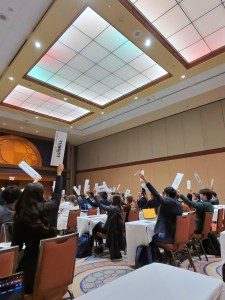
Representatives Discuss Three Opposing Resolutions in IAEA

By: Abby Kirton
Notes pass ferociously and whispers spread across the floor as the International Atomic Energy Agency (IAEA) began deliberations bright and early Sunday morning.
Everybody seemed to want to speak, and when a 30-minute suspension was passed, everyone shot out of their seats at the same time to begin discussion.
GG, AA and BB (NNSI) were the most pressing topics of the morning. All three resolutions seek to increase security and regulate the transportation of radioactive materials, but in vastly different ways.
Representative Hanna Wilhite from Belgium, speaking about working paper AA, said, “a resolution with a smaller scope, focused on regulating and setting standards for radioactive material transport.” With Representative Jessica Key of Vietnam right at her side, she spoke about the scary statistics that show that radioactive material is most commonly stolen while it is in transport.
With a fear of this dangerous material falling out of the hands of capable nations, this resolution seeks to create a special committee within the IAEA. Representative Wilhite stated, “With an emphasis on small nations, we hope to reserve 30 percent of this committee to be for small nations specifically.” This resolution’s focus would be supporting the Member States that want to implement the preexisting transportation standards.
On the other side of the room, draft resolution GG remains at the forefront of the minds of Representatives. GG seeks to regulate and increase security on the transport of radioactive materials, but on a broader scale. It wants to enhance mechanisms already in place by the IAEA to increase nuclear security.
Representative Eliana Mandarano of Cambodia explained that the goal of GG is to increase knowledge and technology information sharing amongst the members of the IAEA.
Placing an emphasis on transparency and collaboration, Representative Mandarano explained they want to use the Trace app, which is used to notify the United Nations (UN) if unauthorized nuclear material crosses borders. This is to ensure these materials do not fall into the hands of non-state actors, and to hold States accountable in the case they misuse their arsenal.
Representative Ethan Vela from the State of Palestine spoke on the resolution BB, or the New Nuclear Security Initiative. Representative Vela explained that this resolution has three pillars. These pillars are regional cooperation, oversight of the transportation of nuclear materials and monitoring this material so the UN can keep track of where these materials are going.
The NNSI wants to take a more regional approach, or as Representative John Bertoncin of the Philippines said, a “bottom up” approach. Representative Bertoncin compared this plan to the theory of herd immunity. They plan to work with regions to make them nuclear safe, which should in turn make the globe safer.
Representative Bertoncin went on to say they hope to work more closely with developing countries, describing resolution BB as “by developing countries, for developing countries.”
Three resolutions are being discussed. Three different perspectives on the same goal of nuclear security. Three press conferences are scheduled for later today. Which resolution will come out on top?
Keep Up With The Accords
More to read
The AMUN Accords is a premier resource for fact-based Model United Nations simulations. We are always looking for new contributors. Want to write for the AMUN Accords? Check out out the submission guidelines and then get in touch!

